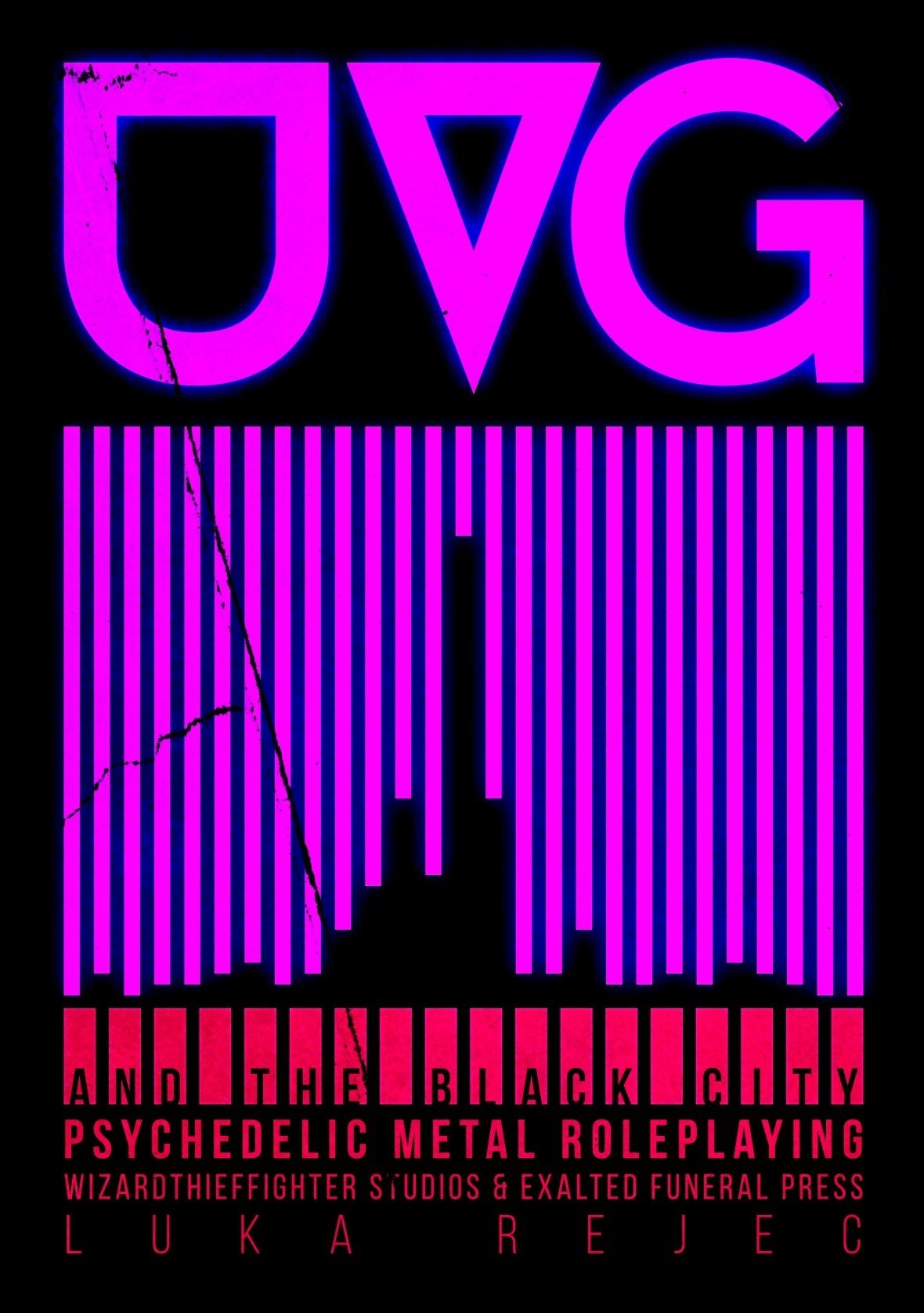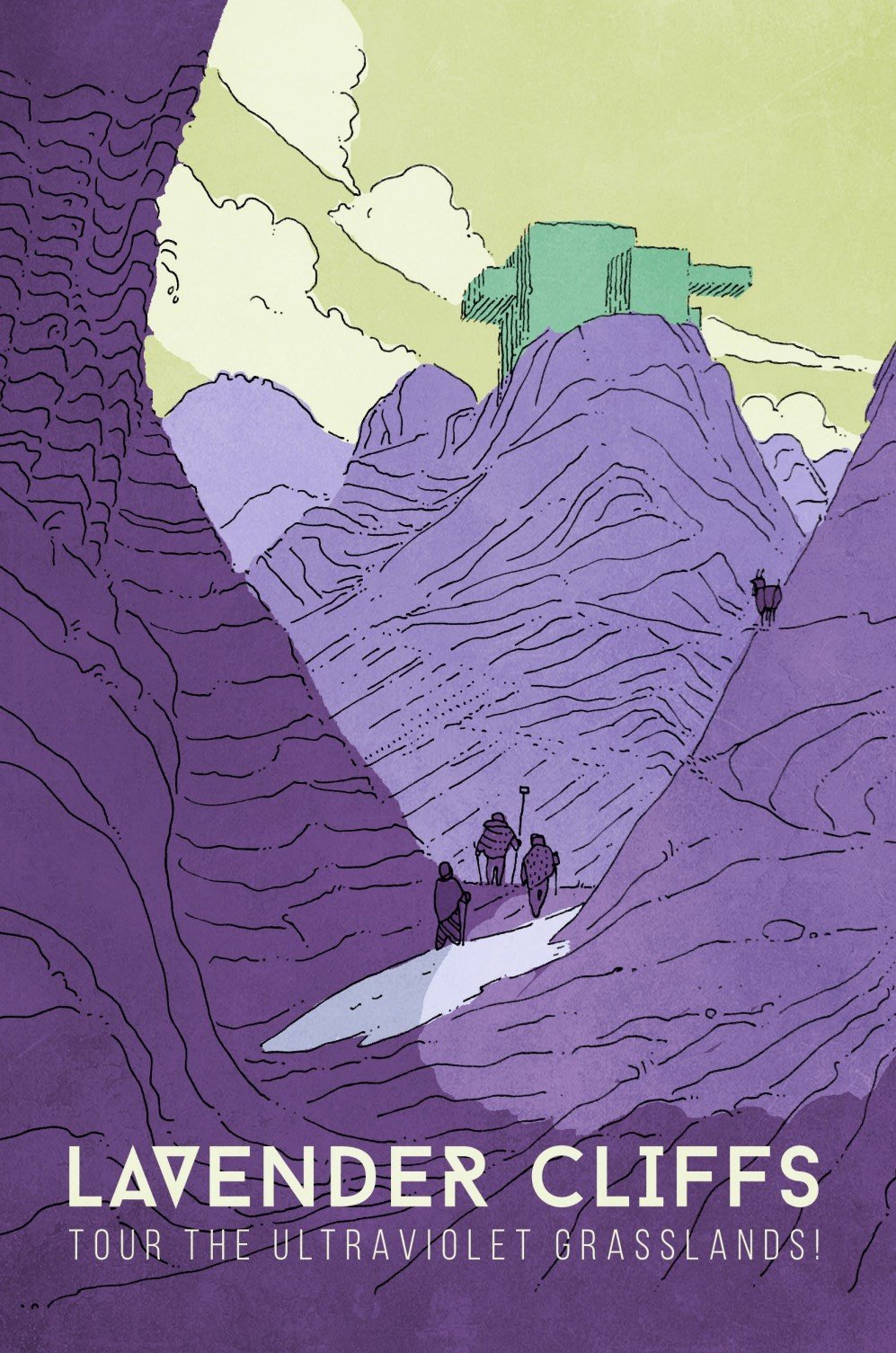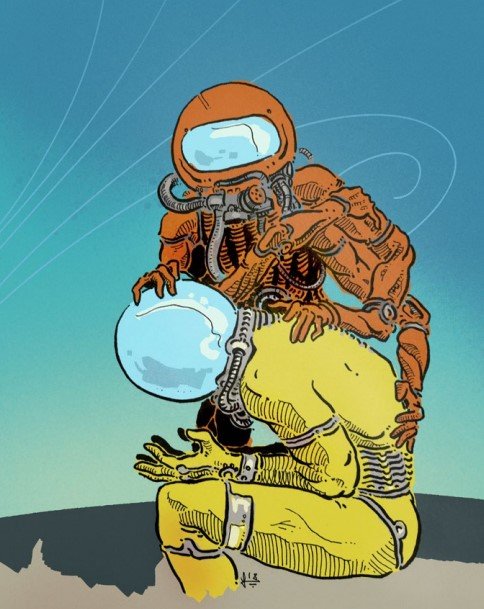Ultraviolet Grasslands: A Heavy Metal d20 Supplement
The last glimmer of the Rainbow before the skin-blistering glow of the Ultraviolet Grasslands.
At the Left End of the Right Road lies humanity’s last outpost before the bewildering and exotic wastes known as the Ultraviolet Grasslands, populated with colorful people, wondrous cat lords, empathic prairie grass, carnivorous meat forests, biomagical mutagens, and magnificent magitechnicals, all tinted in a dreamy, psychedelic, heavy metal haze.
This is the setting for Luka Rejec’s Ultraviolet Grasslands, a game that takes the spirit of an OSR hexcrawl and joins it with a psychedelic Oregon Trail stylized in a sort of JRR Tolkien pastiche. What I’m getting at is that travel is the spirit of the game — Voyaging — Discovery — Navigating the dangers of a bizarre wilderness and relishing in the joy of it. Much like Sam and Frodo and their jaunt across Middle Earth, in this game, players will trek across a world as wondrous as it is mysterious, painted with bizarre and unknown colors as seen through voidblack prisms, painstakingly populated with derelict ruins of ages past, present and future, and presented like the sleeve of a lost heavy metal record from an alternate universe.
Ultraviolet Grasslands leans heavily into its milieu. Much the same way a classic dungeon crawler might painstakingly detail the vibe of a lost dungeon, UVG spends nearly 2/3rds of its length masquerading as something of an encyclopedia, detailing over 32 locations, including the many discoveries that can branch out from there. But the author leaves enough to the imagination that nothing feels absolute and inescapable. No atlas entry that is so concretely deterministic that it can’t be spun up by clever players into something new and whole unto itself. Rather, the seeds are there — some are sprouting as you read, and others will only bear fruit if the table wills it.
Every location is written with lurid, evocative language that leaves the referee with just enough narrative hooks that an eager party should have no shortage of things to do. Not only that, but Rejec offers entire tables of content hooks, like misfortunes to visit on your players, encounters that may fizzle out or spin off into sidequests, people you can hire, places you can visit, and discoveries that populate the local countryside.
This is the end of the Right Road. Humanity’s dominions wind down in the purple haze that wreathes the sunrises of this western reach. No roads, but caravans brave the Ultraviolet Grassland into the eternal sunset of the Black City.
Take the Violet City. Headed by a Jimi Hendrix lyric, it’s the first location available in the book, and is most often the starting location for new players. The book reads, “This is the end of the Right Road. Humanity’s dominions wind down in the purple haze that wreathes the sunrises of this western reach. No roads, but caravans brave the Ultraviolet Grassland into the eternal sunset of the Black City.” The entry is seven pages long. That’s one of the longest in the game other than the Black City itself, on the furthest ends of the Grasslands. I imagine the Violet City is a useful safe haven to return to when the need arises, so of course it might be long compared to others. But regardless, it offers a full-fledged side quest, an exotic location home to the powerful Cat Lords, rules to outfit your caravan, and ways to pass the times in many mundane and debaucherous ways.
Nestled in the book, it’s easy to find a high-resolution map of the grasslands that lays out, rather neatly, all of the primary locations and travel routes, but also offers average travel time at-a-glance. Combine this with the free “Introduction” book available online, and there are virtually no obstacles to starting a game very quickly. The introduction book makes it clear from the get that a “reason” for traveling the grasslands is paramount — information that is buried a little deeply in the base book — but the author offers over a dozen fleshed-out goals an adventuring party can assume before they set out: things as simple as “make money”, or as complex as “see the end of time”.
UVG balances simplicity with replayability.
The rules for travel are simple enough, but robust. Somehow Luka Rejec manages to inject the type of longevity into his world you most often find associated with mainstream games. By joining systems for managing Time, Inventory, and Survival, UVG balances simplicity with replayability. Referees can feel good about setting their players out into the Grasslands knowing the time they themselves spend learning about the world will be well spent because nothing in the book is a one off. Players will often return to once-visited locations to hopefully make use of the hard-earned preparation that referees and game masters so often do.
And with the robust rules guiding travel, trade, managing resources, encounters, and disasters, it makes managing scenarios that may arise in the course of play fairly straightforward. Rejec even manages to mechanize aspects of play that may otherwise seem exploitative or game-breaking in other titles. For example, when players realize they can simply travel between two locations repeatedly to earn money, experience, clout, or otherwise, the book offers rules on essentially subcontracting that labor. Players don’t need to fear leaving behind valuables simply to keep the game moving forward. They can hire henchmen to make the “milk run” for you.
Starting a game is simple enough. I’ve played Ultraviolet Grasslands as something of a Dungeons and Dragons adventure module, visiting the grasslands when suitable, and returning to our base world when we were done. The setting is fully compatible with most d20 systems. But if you want the full UVG experience as the author intended, supplied in the book are the foundations of a system called SEACAT which earns its names from the base stats a player character is imbued with: Strength, Endurance, Agility, Charisma, Aura, and Thought.
SEACATs is by no means a perfect system, but it aims to cut down on the bulk of text so often found with other books and help facilitate a dialogue between players and their Cat (Cat is Rejec’s cute term for game master or referee. His reasoning: every game master knows the term ‘master’ is an exaggeration. At best a GM is like a good bass player. Sure you’re cool. But you’re shining when the whole band is too). This is the way of many Old School Renaissance games, or OSR for short. The goal is to keep the game moving briskly to foster interesting and unique scenarios and keep the players engaged.
On his website, wizardthieffighter.com, Luka Rejec breaks the rules of SEACAT into 12 headings that cover things like, “who the players are”, “what kind of dice to use”, and a few bits about how heroes will level up and engage with the world. Rejec writes, “Here we’re going to cover all of the core of SEACAT right now, in a single blog post. That’s all that the skeleton of any RPG really needs, after all.” He cements his belief in rules-lite systems in the book itself; UVG doesn’t seem to spend more than 12 pages, including a blank character sheet and full-page piece of art, to deliver what every player would need to build a character and get started using SEACAT in their next game.
“...if Hayao Miyazaki adapted Gene Wolfe’s Book of the New Sun.”
Justin Alexander of the Alexandrian.net describes the game’s vibe as “if Hayao Miyazaki adapted Gene Wolfe’s Book of the New Sun.” He says it manages to capture a sense of nostalgia for a place and time that’s never existed. I wish I wrote that line, that’s how much I agree. Few things ignite my spark like a Miyazaki film or a Gene Wolfe book. The psychedelic metal vibe boils off each page and churns my imagination like few game books do.
Even if you have no plans to ever run a game like Ultraviolet Grasslands, it can’t be overstated how much I’ve looked at this book whenever I need a boost of inspiration for my own creative endeavors. I own an incredible number of books, not just medieval war-making manuals, or books on architecture, but game manuals also, that live on my shelf solely for the purpose of occasionally thumbing through them and thinking, “wow, what a cool picture. What cool words. I’m so inspired, I better go make my own cool and inspiring things now.” Factor in that I use this book for its intended purpose, to play games with my friends, and the value can’t be overstated.
If I could, I’d spend $40 American buckaroos to buy the hardcover of this game immediately. But as it stands, that’s been impossible for a few years. And I’m not sure if Rejec’s publisher, Exalted Funeral Press, has any intentions of changing that. But even at $25 dollars for a PDF over at itch.io or drivethruRPG, the value is astonishing. Pick up the “introductory” book for the ease of access to the caravaning rules (what Justin Alexander calls “the Caravan-Crawl”), and you can be ready to go tonight.
And for the budget-conscious tabletop enthusiast, you may get lucky and find Ultraviolet Grasslands on sale or bundled for a discount. In 2021, itch.io bundled it with several other games as part of the “itch.io Selects Summer Tabletop Bundle” — a purchase I’m STILL scrapping gameplay out of.
If the artwork interests you, or the writing captivates you, consider checking out the game on itch.io or drivethruRPG. Luka Rejec is also on Patreon via Wizard Thief Fighter Studios. Consider joining there and getting early access as he tweaks the SEACAT system, and publishes content for UVG 2.0e.
You won’t regret a moment spent in the Ultraviolet Grasslands.
Have you played in the Ultraviolet Grasslands? Let us know how metal it is in the comments!
Thank you for stopping by the Inn at the End, don’t forget to subscribe to this blog and, if you’re into podcasts, be sure to check out Inn at the End on your favorite podcast app.
Grab your sword and keep on adventuring!
Thanks to our Inn at the End regular, Rett, for writing this week’s communication. You can find more about Rett and his motley interests and wide-ranging talents by visiting HERE
-The Inn Keeper-
Enjoy this content? Become an INN-habitant and never miss another episode by following us. We will never misuse or sell your information.














